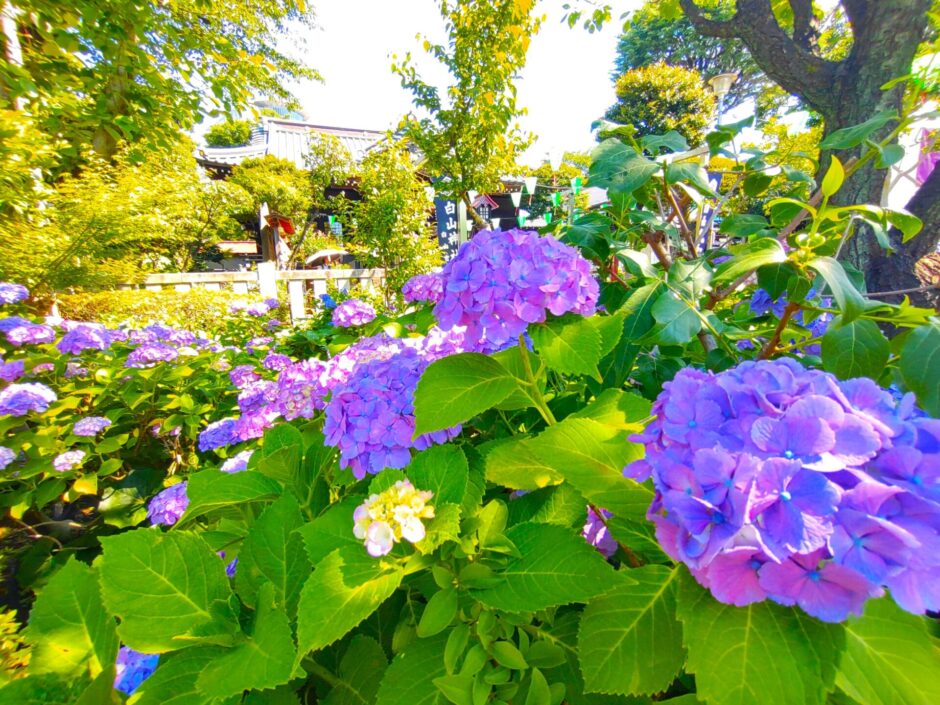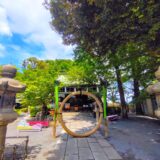【Hakusan Shrine summary】
Hakusan Shrine was founded in 948. It is said that the shrine was built after receiving a request from the Hakusan Hime Shrine in Kaga Province, which is located in the southern part of present-day Ishikawa Prefecture. It was designated as an associate imperial shrine in the Meiji era (1868-1912), and in 1975 it was designated as one of the ten shrines of Tokyo. The shrine is famous for its hydrangea, and the Hydrangea Festival is held every June.
The deities are Kukurihime-no-mikoto, Izanagi-no-mikoto, and Izanami-no-mikoto. Kikurihime-no-Mikoto is the goddess of Mount Hakusan, one of the three most sacred mountains in Japan, and is also called Shirayama-hime. She is said to be the goddess of marriage and the goddess of business negotiations because of her role in the Chronicles of Japan in mediating between Izanami no Mikoto and Izanami no Mikoto when they were about to part from each other in Hades.
【Hakusan Shrine precincts】
![Hakusan Shrine [Tokyo] DSC 0236 1024x768 - Hakusan Shrine [Tokyo]](https://japan-shrine.info/wp-content/uploads/DSC_0236-1024x768.jpg)
This shrine is one of the Hakusan shrines located in Tokyo and other places in Japan. This shrine is the origin of the name of the place called Hakusan and the name of the subway station, indicating that it has been familiar with this area for a long time. Today, it is surrounded by residential and commercial areas.
![Hakusan Shrine [Tokyo] DSC 0239 1 1024x768 - Hakusan Shrine [Tokyo]](https://japan-shrine.info/wp-content/uploads/DSC_0239-1-1024x768.jpg)
The hand-watering basin is atmospheric and magnificent.
![Hakusan Shrine [Tokyo] DSC 0240 Object Removal 1024x768 - Hakusan Shrine [Tokyo]](https://japan-shrine.info/wp-content/uploads/DSC_0240_Object-Removal-1024x768.jpg)
The komainu’s eyes are gold, which is unusual.
![Hakusan Shrine [Tokyo] DSC 0272 1024x768 - Hakusan Shrine [Tokyo]](https://japan-shrine.info/wp-content/uploads/DSC_0272-1024x768.jpg)
小石川植物園本館方面側の階段にも紫陽花が綺麗でした。
【Hakusan Shrine Precincts Sengen Shrine】
![Hakusan Shrine [Tokyo] DSC 0256 1024x768 - Hakusan Shrine [Tokyo]](https://japan-shrine.info/wp-content/uploads/DSC_0256-1024x768.jpg)
Sengen Shrine is located behind the main shrine building as an auxiliary shrine of Hakusan Shrine. The shrine is a small hill higher than the surrounding area and is normally inaccessible due to privacy concerns for the surrounding residents. The shrine is open to the public during the Ajisai Festival. Since the opening time is at 10:00 a.m., we could not see the shrine this time.
【Hakusan Shrine GOSHUIN】
![Hakusan Shrine [Tokyo] 2024 06 08 13 04 Office Lens 729x1024 - Hakusan Shrine [Tokyo]](https://japan-shrine.info/wp-content/uploads/2024_06_08-13_04-Office-Lens-729x1024.jpg)
A red seal is 300 yen to leave a note. Note that the shrine office opens a little late, from 10:00.
【Hakusan Shrine Nearby attractions】
Koishikawa Botanical Garden, Nanya Temple, Nezu Shrine
![Hakusan Shrine [Tokyo] DSC 1374 160x160 - Hakusan Shrine [Tokyo]](https://japan-shrine.info/wp-content/uploads/DSC_1374-160x160.jpg) Nezu Shrine and Otome Inari Shrine [Tokyo]
Nezu Shrine and Otome Inari Shrine [Tokyo]
【Hakusan Shrine Access】
管理人の感想
It is not a large shrine, but it is famous for its hydrangea. The hydrangeas blooming here and there in the shrine grounds are worth seeing, but you may feel that they are a little insufficient for sightseeing. However, since various flowers bloom in each season, why not visit the shrine when you stop by the vicinity? It is better to arrive before 9:00 a.m. on weekends during the Hydrangea Festival, as the place is very crowded with people. However, the shrine office (red seal) opens at 10:00 a.m., so it is a good idea to visit the nearby Koishikawa Botanical Garden and other sightseeing spots.
31-26, Hakusan 5-chome, Bunkyo-ku, Tokyo 112-0001, Japan
※Parking for visitors is available, but please note that it is not available during the Hydrangea Festival and other festivals.
 Tour of Japanese shrines and temples
Tour of Japanese shrines and temples 

![Hakusan Shrine [Tokyo] DSC 0545 150x150 - Hakusan Shrine [Tokyo]](https://japan-shrine.info/wp-content/uploads/DSC_0545-150x150.jpg)
![Hakusan Shrine [Tokyo] DSC 0851 2 150x150 - Hakusan Shrine [Tokyo]](https://japan-shrine.info/wp-content/uploads/DSC_0851_2-150x150.jpg)
![Hakusan Shrine [Tokyo] DSC 1374 150x150 - Hakusan Shrine [Tokyo]](https://japan-shrine.info/wp-content/uploads/DSC_1374-150x150.jpg)
![Hakusan Shrine [Tokyo] DSC 0630 150x150 - Hakusan Shrine [Tokyo]](https://japan-shrine.info/wp-content/uploads/DSC_0630-150x150.jpg)

